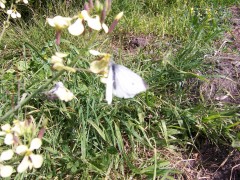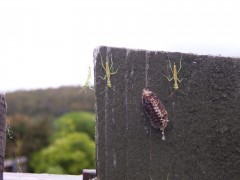On every stem, on every leaf,... and at the root of everything that grew,
was a professional specialist in the shape of grub, caterpillar, aphis, or other
expert, whose business it was to devour that particular part.
~Oliver Wendell Holmes

The white cabbage moth.
It loves to lay eggs on your brassica vegetables.
Photo by Brendan Gasparin.
A large problem facing the organic gardener is that of pests. Without the use of chemical pesticides, plants may seem defenseless against the ravages of the countless bugs and other pest species that can quickly infest a garden. Fortunately, there are many hints and tricks that can aid the gardener in keeping their space free of these menaces.
The most important weapon against pests is vigilance. Just by wandering through the garden on a regular basis and inspecting the plants, the gardener can easily keep tabs on the pest population. Snails, grubs, and cabbage moth eggs can all be removed manually and either relocated or disposed of at the gardener's discretion.
The cabbage moth is a particular nuisance in many Tasmanian gardens. These creatures lay their eggs on the underside of leaves of many brassicas (eg. brocolli, cabbage and kale). The eggs hatch into tiny green caterpillar-like larvae that then proceed to devour the plant. Netting can be used to protect the prone plants, and the larvae are easy enough to spot and remove, but a leaf covered with eggs can be very difficult to remedy without simply removing and discarding the leaf.

The praying mantis, a beneficial creature,
lays its eggs before winter.
Photographed by Brendan Gasparin.
Companion planting can also help to stave off pest infestations. Certain combinations of plants can be used to deter the most common pests of the others. For example, white flowers are said to deter cabbage moths from brassicas. Many grubs, bugs, and insects hate onions and garlic. In fact, a solution of garlic or onion (or even compost or herbivore manure) soaked in water can be sprayed directly on plants as a deterrent. Just make sure you wash everything very thoroughly after harvesting.

In spring, the praying mantis hatchlings
emerge from the egg sack to prey
on the pests in your garden.
Photographed by Brendan Gasparin.
Compost and mulching (and especially mulching with compost) also works to deter pests. When using compost ensure that it is thoroughly decomposed, as loose bits of food stuff may actually draw pests to the garden. Slugs and snails can be repelled using small amounts of egg shell, crushed into small sharp pieces, scattered around problem areas. Do this only with forethought however, as the egg shells may also prove harmful to beneficial creatures such as worms.
Speaking of beneficial creatures, there are many that you should welcome into your garden, such as bees and spiders. Bees pollinate plants, and spiders and other predators serve to keep down the population of pest species. A healthy garden should be full of life of all kinds, not just plant life. One of the benefits of organic gardening over chemical methods is that chemical pesticides can kill indiscriminately, while organic methods can be as precise as the gardener wishes. So before you decide to exterminate a particular species within your garden, take the time to make sure that it is indeed a pest species and not a belevolent one. The creature you are killing may in fact be predator to an even more annoying and destructive species that lurks in your garden.
